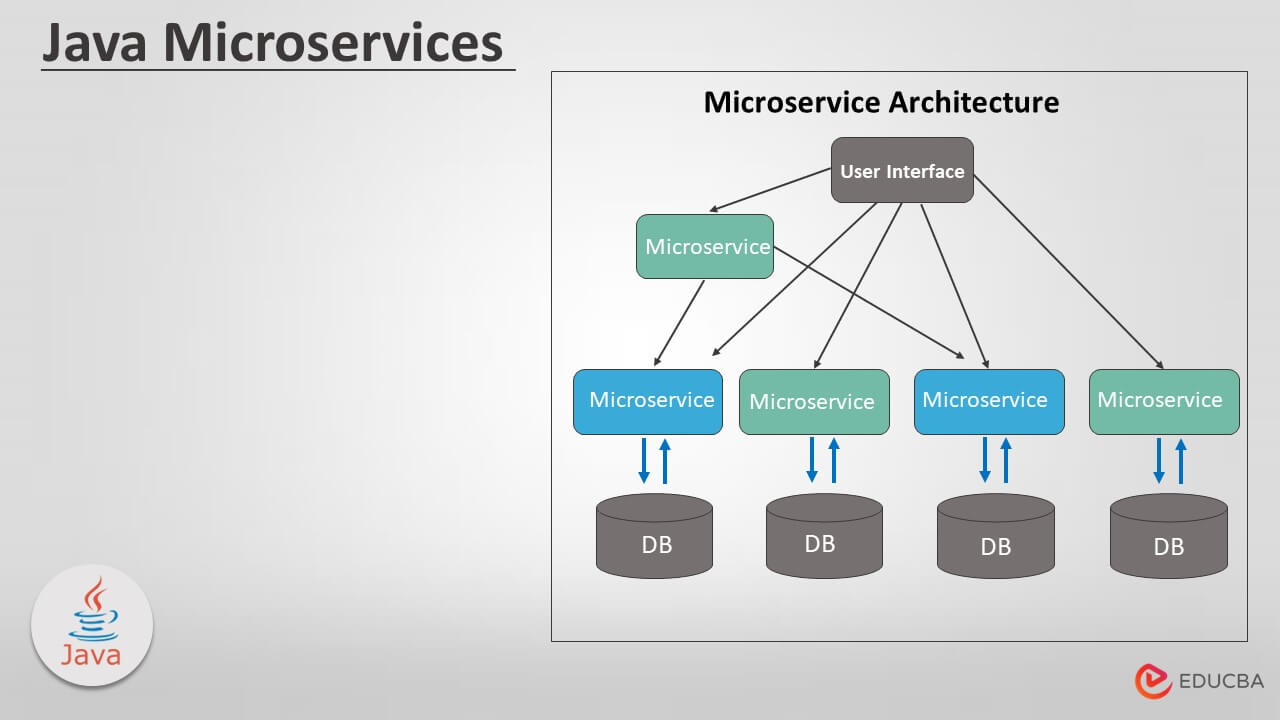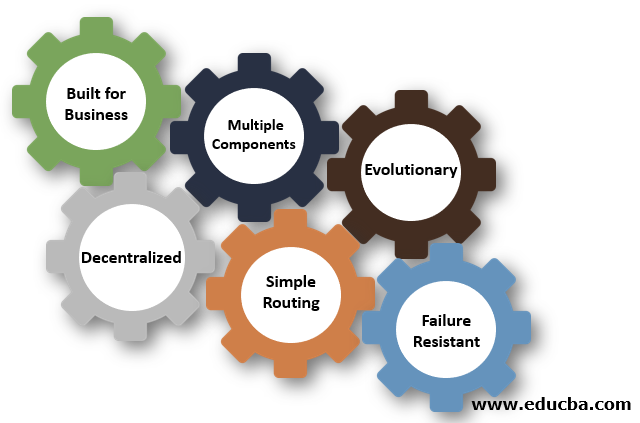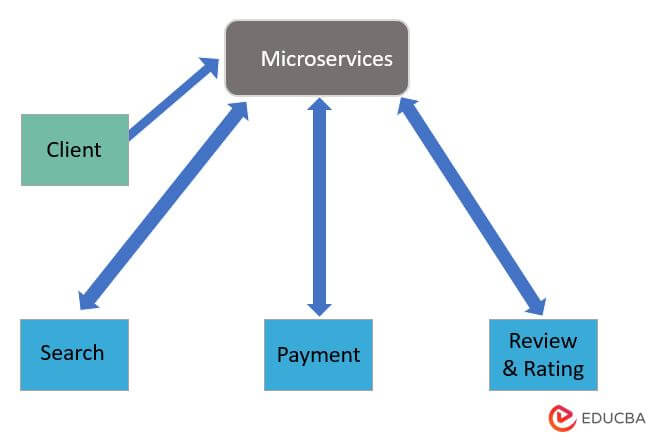Introduction to Java Microservices
Microservices are nothing but a set of applications written in Java language, or we can say that they are typically Java tools and frameworks. Developers usually design microservices for a specified scope and interact with each other with high availability. Each microservice has limited capabilities while we are creating the architecture. The microservice architecture is analogous, so we must assemble it for the desired result.

Table of Contents
- Introduction
- What are Java Microservices?
- How do Java Microservices Work?
- Characteristics of Microservices
- Java Microservices Frameworks
- Architecture of Java Microservices
- Benefits of Java Microservices
- Example of Java Microservices
- Pros and Cons
Key Takeaways
- It is a small Java application, so each microservice is independent.
- It collaborates with the agile process, so we can do a fast sprint iteration and try to fix the bugs.
- It also helps us to reduce the cost due to the agile process.
- It provides scalability architectures to the developer.
What are Java Microservices?
Java microservices are a group of programming applications written in the Java programming language (and regularly influence the huge useful system of different Java tools and frameworks), intended for a restricted scope that works with one another to shape a greater arrangement. As the name implies, every microservice has negligible capacities for modularity, generally creating modules or architecture. A microservices design resembles an assembling sequential construction system, where every microservice resembles a station in the mechanical production system.
Similarly, microservices are expected to have a comparable level of responsibility, each handling a distinct and well-defined task. Each station and microservice are “specialists” in their given liabilities, advancing effectiveness, consistency, and quality in the work process and the results. Contrast that to an assembling climate where each station is liable for building the whole item. This resembles a solid programming application that performs all errands in a similar cycle.
How do Java Microservices Work?
Before going on to the execution, we must know what microservices are. We have already discussed the above point. We understand that each microservice performs a specific task with a limited scope, contributing to effectively achieving the desired results.
Each microservices is nothing but a set of standard deviations which contains the data set. The advantage of microservices is that planning and distinction between the different tasks and, finally, developed applications determine each subtask and execute accordingly. During the execution of microservices, each microservice needs to send output to the next microservice.
Characteristics of Microservices
There are six types of Characteristics are as follows:
1. Built for Business
The design of microservices generally covers company strengths and goals. The cross-functional team uses the microservices architecture in contrast to a conventional monolithic design model, in which different teams have a special focus, such as UIs, servers, technical layers, or server-side logic. That group has the responsibility to produce such products based on one or more services that are transmitted via a message bus.
2. Decentralized
Since micro-services include a range of networks and technologies, old-school central management approaches are not suitable. The micro-services group supports distributed management as its designers are working to create practical tools to solve the same problem as others. Microservice architecture favors decentralized data management, as does decentralized governance. A single logical database for various applications is used by monolithic systems. Usually, every service manages its unique database in a microservice application.
3. Multiple Components
Software designed as a micro-service can be separated into multiple component services by definition. In order to deploy, modify, and then redeploy these services independently, without changing the structure of an application. As a result, one or more distinct systems can only need to be modified rather than entire applications re-deployed.
4. Simple Routing
Microservices function like a standard UNIX system, receiving requests, processing them, and delivering an adequate response. This is opposed to the number of other products, such as Enterprise Service Bus, in which high technology systems are used for messages, choreography, routing, and business rules. You may claim that microservices have intelligent endpoints that process information and use logic and stupid pipes through which information flows.
5. Evolutionary
The evolutionary model is the Microservices architecture and, again, is suitable for evolutionary systems where the computer form that will one day access the application can not be completely anticipated. Many applications start on a monolithic level, but since several unforeseen requirements have arisen, microservices interacting with an older monolithic architecture can be gradually redeveloped through APIs.
6. Failure Resistant
Micro-services are designed to manage failure like a well-rounded child. Considering that a number of specific services communicate with each other for one purpose or another, a system may fail in such cases; the customer should permit its surroundings to operate as gracefully as possible while bowing out. Monitoring it can nevertheless help prevent failure risk. This requirement brings to micro-services more complexity than monolithic systems architecture for obvious reasons.
Java Microservices Frameworks
Different Java-based frameworks are available for creating Java microservices, so let’s see them one by one as follows.
- Spring Boot: It is the most popular framework used to create microservices, or we can say that Java application due to simplification, easy configuration, and security application. With this framework, we can create microservices easily and iterate fast; this is one of the reasons for Spring Boot.
- Jersey: This is another Java-based framework that is used for creating microservices. It is used for the REST web services, and this is one of the communication layers between the microservices.
- Swagger: This is used to create APIs; it is also a Java base, one of the communication layers between the microservices.
- Dropwizard: Dropwizard integrates robust, mature Java libraries in a simple, lightweight bundle that focuses on making things happen in Dropwizard.
- Restlet: The Restlet Project assists Java developers in building better REST system Web APIs.
- Spark: A micro-framework to build web applications with minimal effort in Kotlin and Java 8.
Architecture of Java Microservices
Microservices provide independent space to the developer and administration to build microservices design as per our requirement. A variation of primary style design orchestrates applications as an inexactly coupled help assortment. Microservice Engineering contains fine-grained administrations and lightweight conventions. Developers design microservices to address specific application requirements individually, and they communicate with each other to collectively generate the final result sets.
Let’s see an e-commerce application:
We realize that for any e-commerce business application, there are standard highlights like Inquiry, Survey and Evaluations, and Installments. At that point, when the designer of the Web-based business webpage conveys the application, it is a solitary Solid unit. The code for various elements like Pursuit, Survey, Appraisals, and Installments is on a similar server. To scale the application, you want to run various instances (servers) of these applications.
Benefits of Java Microservices
- We have many advantages when we use microservices; some advantages concern the developer’s point of view, which means they can write good quality code.
- We know that microservices is nothing but a small-scale Java application, and it is based on the problem domain, which we need to implement as well. It also helps us follow the agile process, so they can do fast iteration and determine the new features within the specified schedule.
- It helps the developer resolve bugs immediately, minimizing costs and fewer bugs.
- Microservices are small applications, so they communicate with each other. That means microservices are independent, and the most important benefit is that developers can use any programming language to develop microservices.
Example of Java Microservices
In the above point, we can see how to use microservices with different frameworks, so here, let’s see an example with Spring Boot as follows.
Code:
import org.springframework.boot.*;
import org.springframework.boot.autoconfigure.*;
import org.springframework.stereotype.*;
import org.springframework.web.bind.annotation.*;
@RestController
@EnableAutoConfiguration
public class sampledemo {
@RequestMapping("/")
String index() {
return "Sample demo project will be done";
}
public static void main(String[] args) {
SpringApplication.run(sampledemo.class, args);
}
}Output:
Explanation:
In the above code, we try to implement the microservice in spring boot; the result is shown in the below screenshot.
Pros and Cons
Below given are some Pros and Cons explained.
Pros
- The architecture of Microservice gives developers the freedom to develop and execute products independently
- A relatively small team can develop a microservice
- Simple integration and self-deployment (using open-source software like Hudson, Jenkins, etc.) Current integration.
- Easy for developing people to understand and change, a new member of the team can be quickly productive
- The developers can use the most advanced technologies.
- Start the web container faster so that it is deployed faster
- If changes to a specific part of the application are required, the related component is changed and redeployed then — no need to change the software or replace it.
- Scale-up and convergence of services provided by third parties
- No long-term engineering stack commitment
Cons
- Testing can become complicated and repetitive due to distributed delivery.
- More services can lead to blocks of information.
- The architecture is additionally complex as programmers must reduce network latency and fault tolerance and tackle a variety of message and load-balancing formats.
- Increasing numbers of services can complicate integration and the management of whole products.
- In addition to several complexities of monolithic architecture, developers must address a distributed system’s further complexity.
- Developers will make more efforts to apply the interaction process between services.
- Managing cases involving more than one company without using centralized transactions not only complicates matters but also necessitates communication and cooperation between teams.
FAQ
Given below are the FAQs:
Q1. Is Java suitable for microservices?
Answer: The answer is yes because Java is the most popular programming language, and we can easily develop microservices in Java. Java provides the annotation syntax to the developer.
Q2. How and what types of microservices are present in Java?
Answer: There are 3 different types of microservices, such as discovery server, authentication service, and consumer microservice, used for the client.
Q3. Which is the best framework for microservices implementation?
Answer: There are different types of frameworks available to implement microservices, such as Spring Boot, quarks, eclipse, and Ballerina.
Conclusion
Java’s mature ecosystem makes it a popular choice for microservices. It offers strengths in scalability, modularity, and a strong developer community. However, it also comes with potential complexity and resource overhead that organizations must consider carefully before adopting Java for microservices.
Recommended Articles
We hope that this EDUCBA information on “Java Microservices” was beneficial to you. You can view EDUCBA’s recommended articles for more information.



